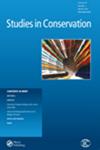数字技术在中国传统家具中的应用综述
IF 0.8
4区 化学
0 ARCHAEOLOGY
引用次数: 0
摘要
摘要本研究以中国传统家具的物质文化遗产为背景,探讨数字技术在当代的运用。数字技术是指利用计算机和电子设备来处理、存储、传输和显示信息,可以用来修复和保护传统家具。例如,可以通过数据整合保存与中国传统家具相关的宝贵信息资源,以便进一步利用和开发。数字技术的这种应用还处于探索阶段,研究内容相对分散,缺乏系统的认识。本文将目前数字技术在传统家具领域的应用分为四大类:数据库技术、数字修复技术、数字鉴定技术、数字展示技术。每一个都有系统的描述。数据库技术包括数据采集、数据预处理、模型构建和平台搭建;数字修复技术主要集中在家具结构和图案的修复上。数字鉴定包括年代鉴定、木材鉴定、漆膜成分鉴定、结构力学性能鉴定等。数字展览包括数字博物馆、虚拟现实、增强现实和全息投影技术的使用。此外,深入探讨了数字技术集成可能带来的各种警告、限制和重点,并对传统家具领域的数字化应用进行了简要的综合,同时对其固有缺陷进行了批判性评估。我们试图分析这些技术特征,以建立对与中国传统家具相关的数字技术应用和发展趋势的全面理解。本研究面向文物保护专业人士,可为提高数字系统的利用和应用,有效保护传统家具提供参考。关键词:中国传统家具数据库技术数字修复数字鉴定数字展览披露声明作者未报告潜在利益冲突。本研究由南京林业大学资助;本研究获“东西方视角下中国古典家具海外传播与文化认同研究”项目资助。本文章由计算机程序翻译,如有差异,请以英文原文为准。
Application of Digital Technology to Chinese Traditional Furniture: A Review
ABSTRACTThis research delves into the contemporary utilization of digital technology within the context of the material cultural heritage associated with traditional Chinese furniture. Digital technology refers to the use of computers and electronic devices to process, store, transmit, and display information, which can be used to restore and protect traditional furniture. Valuable informational resources relevant to Chinese traditional furniture, for example, can be preserved through data integration for further utilization and development. Such applications of digital technology are still in the exploratory stage and as research content is relatively scattered, a systematic understanding is still lacking. The current applications of digital technologies in the field of traditional furniture are separated into four categories in this paper: database technology, digital restoration, digital identification, and digital exhibition. Each is described systematically. Database technology includes data acquisition, data pretreatment, model building, and platform construction; digital restoration technology mainly centers on the restoration of furniture structures and patterns. Digital identification includes the identification of age, wood, lacquer film composition, and structural mechanical performance. Digital exhibition includes digital museums, virtual reality, augmented reality, and the use of holographic projection technology. Additionally, an in-depth exploration was conducted into a comprehensive range of admonitions, constraints, and focal points that may ensue from the integration of digital technology, and a concise synthesis was presented regarding the digitization applications in the realm of traditional furniture, along with a critical assessment of their inherent deficiencies. We seek to analyze these technical features to establish a comprehensive understanding of digital technology application and development trends relevant to Chinese traditional furniture. This work is geared towards the conservation professional and may provide a reference for improving the utilization and application of digital systems for the effective preservation of traditional furniture.KEYWORDS: Chinese traditional furnituredatabase technologydigital restorationdigital identificationdigital exhibition Disclosure statementNo potential conflict of interest was reported by the author(s).Additional informationFundingThis work has been supported by Nanjing Forestry University; the study was funded by the project of ‘The Study on Overseas Dissemination and Cultural Identity of Chinese Classical Furniture from the Perspective of East and West’.
求助全文
通过发布文献求助,成功后即可免费获取论文全文。
去求助
来源期刊

Studies in Conservation
化学-分析化学
CiteScore
1.80
自引率
12.50%
发文量
73
审稿时长
>12 weeks
期刊介绍:
Studies in Conservation is the premier international peer-reviewed journal for the conservation of historic and artistic works. The intended readership includes the conservation professional in the broadest sense of the term: practising conservators of all types of object, conservation, heritage and museum scientists, collection or conservation managers, teachers and students of conservation, and academic researchers in the subject areas of arts, archaeology, the built heritage, materials history, art technological research and material culture.
Studies in Conservation publishes original work on a range of subjects including, but not limited to, examination methods for works of art, new research in the analysis of artistic materials, mechanisms of deterioration, advances in conservation practice, novel methods of treatment, conservation issues in display and storage, preventive conservation, issues of collection care, conservation history and ethics, and the history of materials and technological processes. Scientific content is not necessary, and the editors encourage the submission of practical articles, review papers, position papers on best practice and the philosophy and ethics of collecting and preservation, to help maintain the traditional balance of the journal. Whatever the subject matter, accounts of routine procedures are not accepted, except where these lead to results that are sufficiently novel and/or significant to be of general interest.
 求助内容:
求助内容: 应助结果提醒方式:
应助结果提醒方式:


